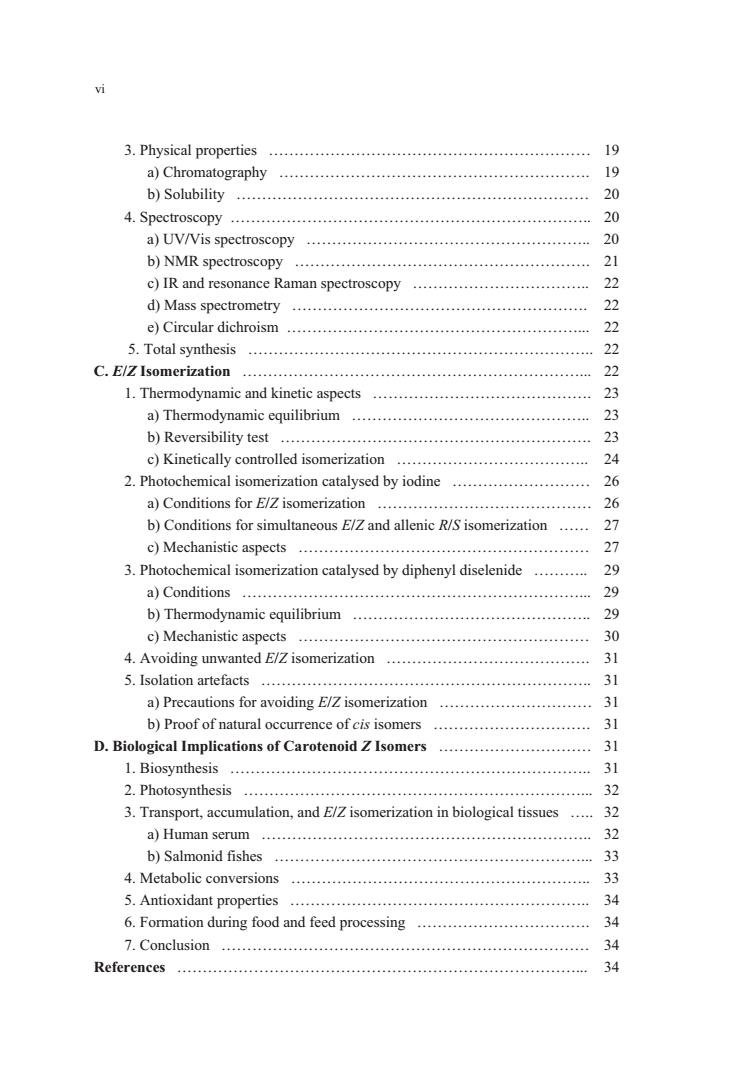正在加载图片...

3.Physical properties 9 a)Chromatography b)Solubility 20 4.Spectrosc0py… 20 a)UV/Vis spectroscopy 20 b)NMR spectroscopy 21 c)IR and resonance Raman spectroscopy 22 d)Mass spectrometry 22 e)Circular dichroism...... 22 5.Total synthesis 22 C.E/z Isomerization.................. 1.Thermodynamic and kinetic aspects 23 a)Thermodynamic equilibrium 23 b)Reversibility test. 23 c)Kinetically controlled isomerization 24 2.Photochemical isomerization catalysed by iodine 26 a)Conditions for E/Z isomerization 26 b)Conditions for simultaneous E/Z and allenic R/S isomerization...... 3 c)Mechanistic aspects 27 3.Photochemical isomerization catalysed by diphenyl diselenide. 29 a)Conditions 29 b)Thermodynamic equilibrium 29 c)Mechanistic aspects 30 4.Avoiding unwanted E/Zisomerization 31 5.Isolation artefacts. 31 a)Precautions for avoiding E/Z isomerization 31 b)Proof of natural occurrence of cis isomers ....... 31 D.Biological Implications of Carotenoid Z Isomers.... 31 1.Biosynthesis 31 2.Photosynthesis 32 3.Transport,accumulation,and E/Zisomerization in biological tissues a)Human serum....4.. b)Salmonid fishes 33 4.Metabolic conversions 5.Antioxidant properties 34 6.Formation during food and feed processing 4 7.Conclusion… 34 References 34 vi 3. Physical properties ……………………………………………………… 19 a) Chromatography ……………………………………………………. 19 b) Solubility …………………………………………………………… 20 4. Spectroscopy …………………………………………………………….. 20 a) UV/Vis spectroscopy ……………………………………………….. 20 b) NMR spectroscopy …………………………………………………. 21 c) IR and resonance Raman spectroscopy …………………………….. 22 d) Mass spectrometry …………………………………………………. 22 e) Circular dichroism …………………………………………………... 22 5. Total synthesis ………………………………………………………….. 22 C. E/Z Isomerization …………………………………………………………... 22 1. Thermodynamic and kinetic aspects ……………………………………. 23 a) Thermodynamic equilibrium ……………………………………….. 23 b) Reversibility test ……………………………………………………. 23 c) Kinetically controlled isomerization ……………………………….. 24 2. Photochemical isomerization catalysed by iodine ……………………… 26 a) Conditions for E/Z isomerization …………………………………… 26 b) Conditions for simultaneous E/Z and allenic R/S isomerization …… 27 c) Mechanistic aspects ………………………………………………… 27 3. Photochemical isomerization catalysed by diphenyl diselenide ……….. 29 a) Conditions …………………………………………………………... 29 b) Thermodynamic equilibrium ……………………………………….. 29 c) Mechanistic aspects ………………………………………………… 30 4. Avoiding unwanted E/Z isomerization …………………………………. 31 5. Isolation artefacts ……………………………………………………….. 31 a) Precautions for avoiding E/Z isomerization ………………………… 31 b) Proof of natural occurrence of cis isomers …………………………. 31 D. Biological Implications of Carotenoid Z Isomers ………………………… 31 1. Biosynthesis …………………………………………………………….. 31 2. Photosynthesis …………………………………………………………... 32 3. Transport, accumulation, and E/Z isomerization in biological tissues ….. 32 a) Human serum ……………………………………………………….. 32 b) Salmonid fishes ……………………………………………………... 33 4. Metabolic conversions ………………………………………………….. 33 5. Antioxidant properties ………………………………………………….. 34 6. Formation during food and feed processing ……………………………. 34 7. Conclusion ……………………………………………………………… 34 References ……………………………………………………………………... 34